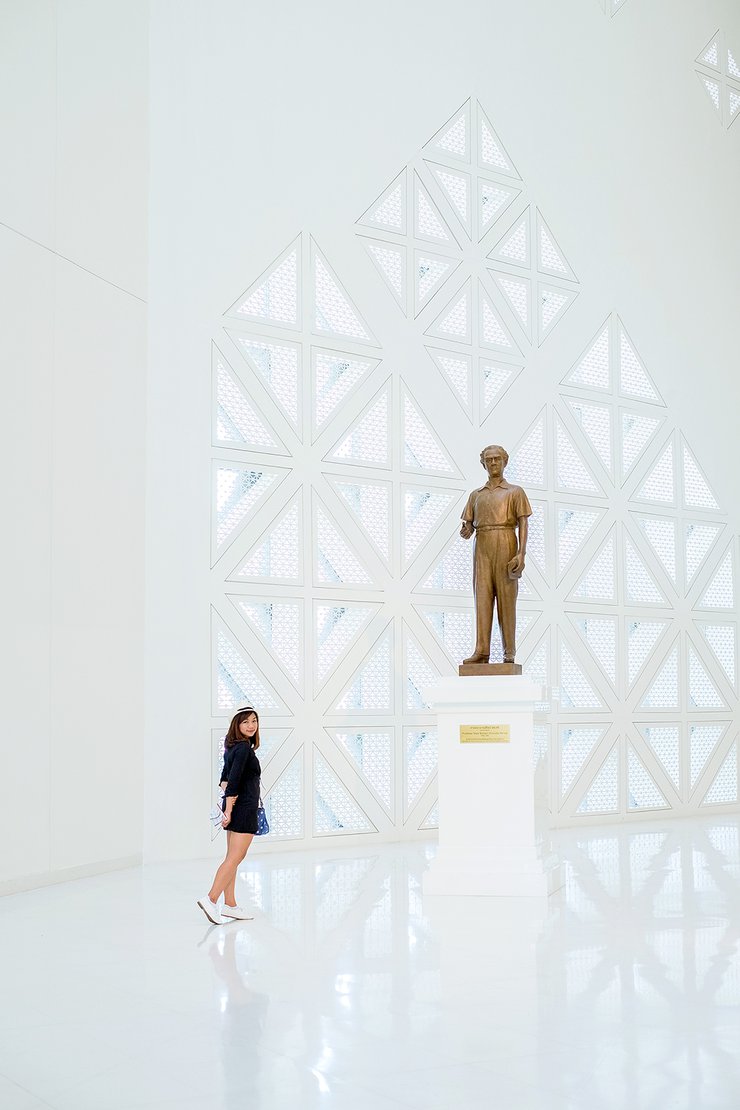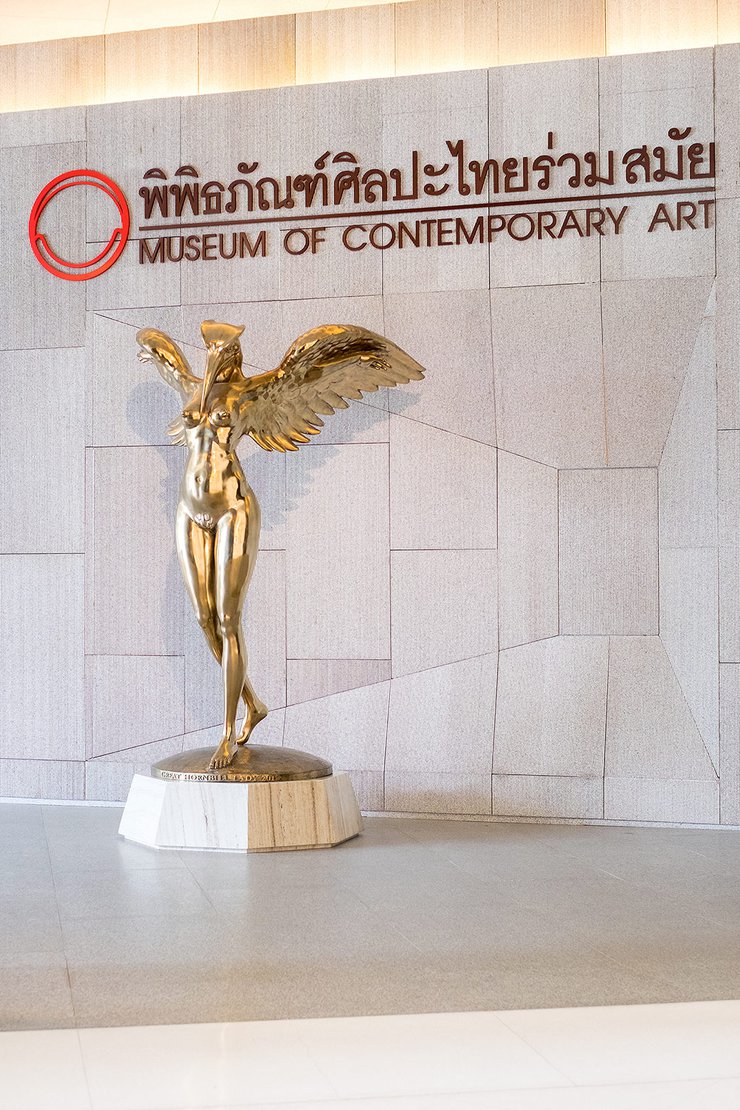Hello everyone, today I, "Mr. Wife's errands, Husband's work", will take you all to visit the Museum of Contemporary Art, or MOCA for short.
I had heard about MOCA for many years, but I never had the chance to visit it. Last week, I saw two or three friends on Facebook who went there at the same time. They said that MOCA was offering free admission to commemorate Professor Silpa Bhirasri, the father of modern Thai art, who coined the phrase "Ars longa, vita brevis: Art is long, life is short."
Note: The phrase "Ars longa, vita brevis (Art is long, life is short)" was not originally coined by Professor Silpa Bhirasri, but he often quoted it and it became widely remembered.

The Museum of Contemporary Art (MOCA)
MOCA is conveniently located near Kamphaeng Phet 6 Road, directly opposite Kasetsart University on Vibhavadi Rangsit Road. Visitors can easily find the museum using Google Maps.
MOCA is open from Tuesday to Sunday (closed on Mondays). Admission fees are 250 baht for adults and 100 baht for students. Special family rates are available, and certain individuals are granted free entry.
The full details can be seen in the image below.

Upon arrival at MOCA, visitors are greeted by a towering white building adorned with intricate jasmine stem patterns and elegant light channels embedded within its walls. The building's design exudes a minimalist yet sophisticated aesthetic. For those arriving without a vehicle, tickets can be purchased directly at the entrance. Drivers can access the underground parking lot by following the designated route. While the parking capacity may seem limited, with an estimated 40 available spaces, concerns about finding a spot are largely unfounded. Even during my visit on a Sunday afternoon, coinciding with a free admission day, the parking lot remained remarkably spacious.
For those who drive, there is a beautiful walkway between the parking lot and the entrance of MOCA. On a sunny day, it would be a great place to take photos. However, the day I went, the lighting was terrible, so I didn't take any pictures. The entrance and exit doors are also very well designed, closing flush against the wall like a secret door in a movie.

Upon arrival at the ticketing area, unlike on regular days where purchasing tickets at the designated price is required, we simply informed the staff of the number of people in our group. The staff then promptly printed special "in memory of Silpa Bhirasri" tickets at no cost, along with MOCA brochures.
*Silpa Bhirasri Day falls on September 15th of each year. This year, MOCA is offering free admission to everyone from September 13th to 20th.


The MOCA's visitor guidelines allow photography, with a few exceptions.
1. No flash photography allowed.
2. No tripods allowed.
3. Photography is strictly prohibited in a designated special room on the 5th floor, which is the top floor.
4. Large bags exceeding the size limit are strictly prohibited. These bags will be checked at the ticket booth and must be deposited there. Bags allowed inside must not exceed 36x56x23 cm.
Faced with the restrictions mentioned in point 4, I was forced to carefully consider my equipment choices. Ultimately, I opted for the Fuji X-t10 with the 35mm f1.4 lens as my primary setup, keeping it readily accessible around my neck. The 10-24mm lens was entrusted to my wife's handbag. As it turned out, this decision proved to be the right one, as over 90% of the photographs I captured that day were taken with the 35mm f1.4 lens.
Can you please show me the size of your wife's bag? I want to know how big it is.


Alright, everyone should be ready to see some beautiful artwork now. Let me start with this picture, which is almost like a symbol of MOCA. We can see it from the ticket booth, but the angle I took this picture from requires you to walk into the building first.

After entering the building, you will find staff checking tickets near the statue.

The statue of Professor Silpa Bhirasri is a must-see. The surrounding space is aesthetically pleasing and offers numerous photo opportunities.

Nearby, there is a statue of an artist painting, and there is also a beautiful light well on the wall for us to take pictures.



MOCA spans five floors, although its exterior suggests a ten-story building due to the impressive six-meter-high ceilings on each level. Restrooms are conveniently located on every floor, and visitors can choose between elevators, stairs, or escalators for vertical movement.
The first floor, or G floor, is divided into four main sections:
The first section features two rotating exhibitions.
Part 2 is a permanent exhibition honoring two National Artists in the field of Visual Arts (Sculpture): Professor Emeritus Chalood Nimsamer and Mr. Phaitoon Meuangsomboon.
Section 3: Museum Shop or Souvenir Shop
Part 4: Café
This section provides a space for relaxation after taking in the extensive collection of beautiful artwork.
Here is a general overview.





This floor also features beautiful paintings by all six National Artists.
The exhibition's most notable feature is its excellent signage. Each floor's artwork information signs are comprehensive, with some even providing extensive explanations of the concepts behind the pieces.


Don't assume that all the artworks displayed in MOCA are just ordinary sculptures or paintings. Many pieces, when viewed up close, will leave you stunned and amazed by the incredible detail. Several works incorporate mixed media, and many have unique textures. For example, in the first image below, the three or four black logs in the picture, when viewed closely, appear to protrude from the rest of the image.



The second to fifth floors house a permanent exhibition, essentially a museum showcasing the art collection of Boonchai Bencharongkul, the owner of the MOCA building, amassed over 35 years. The collection features works by over 200 renowned artists!
"Let me give you a general overview first, and then we can focus on specific highlights later. Taking pictures in this building is quite easy because there are very few people. More importantly, there is plenty of natural light."





Although I am not an expert in this field and my knowledge of art is limited, many works of art have left me in awe of their scale, detail, concept, and presentation.






As mentioned earlier, many works have detailed descriptions on the side of the artwork, such as this image of the Churning of the Ocean of Milk.


The third floor also features a highlight: the Nang Phim House, a wooden house that tells the story of Nang Phim Philai and Khun Chang-Khun Phaen. The paintings inside are beautiful.
Note: After returning, I learned that there is a pencil sketch by Hem Vejakorn, an artist from fifty years ago, on the wall next to the Khun Chang Khun Phaen room. It is the original image with a poem about Khun Chang Khun Phaen. They say it's a classic. So, if anyone has the chance to follow in my footsteps, don't miss it like I did. T_T



The fourth floor houses the works of Professor Thawan Duchanee, a National Artist in Visual Arts (Painting) and a legendary figure in contemporary Thai art. This floor showcases all types of his works.
Those who appreciate the artist's work should definitely not miss this exhibition. The presentation on this floor is particularly captivating due to the incorporation of red and black walls, which contrast with the white walls of other floors, creating a powerful and dynamic atmosphere.
Note: In addition to the works of Professor Thawan Duchanee, this floor also features a rare collection of works by other prominent Thai artists.





The highlight of this floor is the "Bridge Across the Universe" walkway, which leads you to three magnificent 7-meter-tall paintings. The sheer scale and beauty of these artworks are truly awe-inspiring.
This series of works, titled "Traiphum," narrates the cycle of birth, death, and rebirth of all beings in samsara, according to Buddhist beliefs. The works were created by Somphob Butarach, Panya Vijinthanasarn, and Prateep Kochabua.



The museum has strategically placed seating throughout the exhibition, ensuring a comfortable viewing experience. Visitors can relax and appreciate the artwork without worrying about fatigue. Notably, some seats boast unique designs, adding to the overall aesthetic appeal.
Black and white photography enthusiasts will appreciate this location, as the space features beautiful lighting with multiple light sources.



The Fifth Floor: A Global Art Gallery
The fifth floor of the museum transcends the boundaries of Thai art, showcasing a diverse collection of international masterpieces. A highlight is the Richard Garden, a meticulously recreated European exhibition hall featuring a stunning glass-domed ceiling that bathes the space in natural light. This gallery houses an impressive array of European paintings by renowned artists from the Victorian era, a period that coincides with the reign of King Rama V of Thailand. Some of these remarkable works date back nearly 300 years, offering a glimpse into the artistic brilliance of a bygone era.
- The Richard Garden room is the only room in MOCA where photography is not permitted.
Okay, after we've finished admiring the artwork on all five floors, before heading home, I recommend everyone stop by for a break and enjoy a delicious drink on the G floor. There's a shop with a unique look that offers this service. The shop itself is stylish, especially the second floor, but you can choose to sit and eat either in the G floor hall or in the outdoor garden.
Is there anything else I can help you with?
The shop offers a variety of beverages, including tea, coffee, and bakery items. My wife and I ordered Thai tea and a White Chocolate blended drink. The prices were reasonable considering the location, averaging 70-80 baht per glass. However, the drinks were a bit too sweet for our taste.


The outdoor garden is quite beautiful, especially in the evenings when it is likely to be pleasantly cool. More importantly, it is an excellent location for portrait photography.





Conclusion of My Visit to the Museum
My visit to the museum was a truly rewarding experience, especially for art enthusiasts. The entrance fee of 250 baht per person is incredibly reasonable considering the vast collection of priceless artworks on display. The sheer number of valuable pieces, estimated to be worth hundreds of millions, housed within a single building is remarkable.
Furthermore, the museum was pleasantly uncrowded, allowing for a comfortable and intimate viewing experience. The staff was exceptionally friendly and helpful, adding to the overall positive impression.
Art enthusiasts can easily spend an entire day exploring the exhibits. For those who are not yet passionate about art, I encourage you to keep an open mind and visit the museum. If the 250 baht entrance fee seems high, keep an eye out for free admission days or discounts.
This concludes our review. If there are any omissions or errors, please forgive me. If you enjoy my reviews, you can follow or provide feedback here: https://www.facebook.com/amazingcouples
Thank you all for reading to the end. See you again in the next review. Goodbye.

ภรรยาหา สามีใช้
Friday, September 27, 2024 10:27 AM















